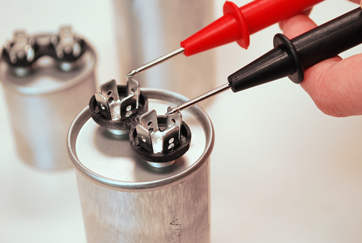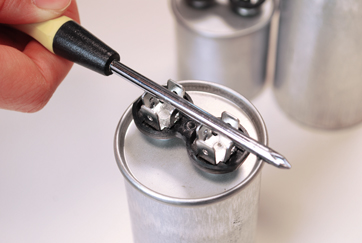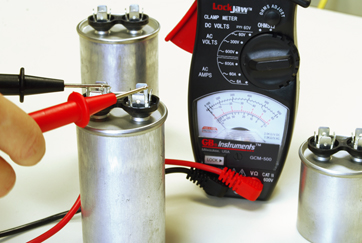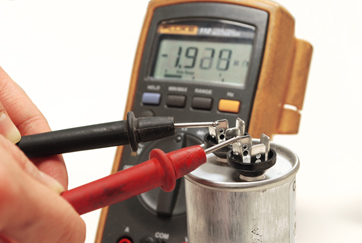How to test a air conditioner capacitor?
An air conditioner capacitor is used to continuously adjust current or phase shift to a motor’s windings in an effort to optimise the motors torque and efficiency performance. Most electric motor run cap applications use a rating of 2.5-100 uf (microfarads) capacitance and voltages of 370 or 440.
1.Dis-connect power to test air conditioner capacitor

Start by making the motor safe to test by disconnecting power. Ideally, the unit should be unplugged, but shutting off a circuit breaker or disconnect may be adequate provided it can be locked out against accidental re-engagement. The test capacitor procedure must only be carried out after it has been verified that power is no longer present.
2.Check for residual voltage at test air conditioner capacitor

Whenever you plan to test capacitor condition or electrical value, it is a vital practice to remove any residual power that may still be stored. Using the metal blade of a screwdriver with an insulated handle will allow you to discharge any stored voltage by simply shorting the terminals of the capacitor. The test capacitor may emit a spark and a pop sound upon discharge. This is normal.
Remove test capacitor from the circuit
You’ll need to remove the capacitor from the circuit before performing a test. Disconnect one or both terminals from the motor to the test capacitor to remove it from the circuit. Disconnecting only one side will perform the desired result but leaves the capacitor dangling from the motor, making probing a little more difficult.
3.Remove test air conditioner capacitor from the circuit

An analog multi-meter may be used to test capacitor condition for a dead-or-alive basic test. Start by setting the meter to “Ohms” at 1k scale. Conecting the probes to each side of the capacitor’s terminals (measure across the capacitor as if it were a battery), you will be watching for a specific sequence of needle movement.
Note: AC capacitors used for electric motors are non-polarized and therefore do not have a positive or negative terminal. It does not matter which terminal orientation you use to test capacitor condition.
If the needle quickly starts at zero then rises in resistance as a charge builds, the test capacitor is likely still good. If the resistance falls to zero and does not climb, the capacitor is bad. If the capacitor has no continuity as in no connection across the terminals, the capacitor is also bad.
4. Test Capacitor (specific value) using a digital multi-meter

Many mid level digital multi-meters provide the ability to measure actual capacitance value of a test capacitor. Connect the probes to the capacitor’s terminals, set the meter to test capacitor, and read the value displayed. Most capacitors will have a manufactured tolerance (accuracy of actual value compared to actual value) when new of +/-10% or less as compared to the marked value. Capacitors generally fall in value as they wear and should be replaced once a test capacitor has fallen below this range.
Tags: measure capacitor, motor run capacitor, test capacitor


